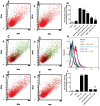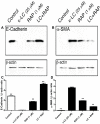Receptor-associated protein blocks internalization and cytotoxicity of myeloma light chain in cultured human proximal tubular cells
- PMID: 23894629
- PMCID: PMC3720907
- DOI: 10.1371/journal.pone.0070276
Receptor-associated protein blocks internalization and cytotoxicity of myeloma light chain in cultured human proximal tubular cells
Abstract
Background: Free light chains (LCs) are among the many ligands that bind to cubilin/megalin for endocytosis via the clathrin-dependent endosomal/lysosomal pathway. Receptor associated protein (RAP), is a 39 kDA high-affinity, chaperone-like ligand for megalin that assists in the proper folding and functioning of megalin/cubilin. Although RAP is known to inhibit ligand binding to megalin/cubilin, its effect on LC endocytosis has not been shown directly.
Methods and principal findings: We investigated whether RAP can block the endocytosis of LC in cultured human proximal tubule cells and whether this can prevent LC cytotoxicity. Immunofluorescence microscopy and flow cytometry showed that fluorescently labeled LC endocytosis was markedly inhibited in HK-2 cells pretreated with human RAP. The effect of RAP was dose-dependent, and was predominantly on endocytosis as it had no effect on the small acid-washable fraction of LC bound to cell membrane. RAP significantly inhibited LC induced cytokine production and phosphorylation of ERK1/2 and p38 MAPK. Prolonged exposure to LC for 48 h resulted in epithelial-to-mesenchymal transformation in HK-2 cells as evidenced by marked reduction in the expression of the epithelial cell marker E-cadherin, and increased the expression of the mesenchymal marker α-SMA, which was also prevented by RAP in the endocytosis medium.
Conclusions: RAP inhibited LC endocytosis by ∼88% and ameliorated LC-induced cytokine responses and EMT in human PTCs. The results not only provide additional evidence that LCs endocytosis occurs via the megalin/cubilin endocytic receptor system, but also show that blocking LC endocytosis by RAP can protect proximal tubule cells from LC cytotoxicity.
Conflict of interest statement
Figures





Similar articles
-
Receptor-associated protein impairs ligand binding to megalin and megalin-dependent endocytic flux in proximal tubule cells.Am J Physiol Renal Physiol. 2023 Oct 1;325(4):F457-F464. doi: 10.1152/ajprenal.00165.2023. Epub 2023 Aug 3. Am J Physiol Renal Physiol. 2023. PMID: 37534387 Free PMC article.
-
Silencing megalin and cubilin genes inhibits myeloma light chain endocytosis and ameliorates toxicity in human renal proximal tubule epithelial cells.Am J Physiol Renal Physiol. 2008 Jul;295(1):F82-90. doi: 10.1152/ajprenal.00091.2008. Epub 2008 Apr 30. Am J Physiol Renal Physiol. 2008. PMID: 18448595
-
Myeloma light chains induce epithelial-mesenchymal transition in human renal proximal tubule epithelial cells.Nephrol Dial Transplant. 2008 Mar;23(3):860-70. doi: 10.1093/ndt/gfm670. Epub 2007 Oct 12. Nephrol Dial Transplant. 2008. PMID: 17933841
-
Megalin and cubilin: synergistic endocytic receptors in renal proximal tubule.Am J Physiol Renal Physiol. 2001 Apr;280(4):F562-73. doi: 10.1152/ajprenal.2001.280.4.F562. Am J Physiol Renal Physiol. 2001. PMID: 11249847 Review.
-
Chloride channels and endocytosis: new insights from Dent's disease and ClC-5 knockout mice.Nephron Physiol. 2005;99(3):p69-73. doi: 10.1159/000083210. Nephron Physiol. 2005. PMID: 15637424 Review.
Cited by
-
The Proximal Tubule Toxicity of Immunoglobulin Light Chains.Kidney Int Rep. 2021 Mar 3;6(5):1225-1231. doi: 10.1016/j.ekir.2021.02.026. eCollection 2021 May. Kidney Int Rep. 2021. PMID: 34013100 Free PMC article. Review.
-
Druggable Sphingolipid Pathways: Experimental Models and Clinical Opportunities.Adv Exp Med Biol. 2020;1274:101-135. doi: 10.1007/978-3-030-50621-6_6. Adv Exp Med Biol. 2020. PMID: 32894509 Review.
-
Regulation of Prostate Androgens by Megalin and 25-hydroxyvitamin D Status: Mechanism for High Prostate Androgens in African American Men.Cancer Res Commun. 2023 Mar 3;3(3):371-382. doi: 10.1158/2767-9764.CRC-22-0362. eCollection 2023 Mar. Cancer Res Commun. 2023. PMID: 36875158 Free PMC article.
-
Aristolochic acid I induces proximal tubule injury through ROS/HMGB1/mt DNA mediated activation of TLRs.J Cell Mol Med. 2022 Aug;26(15):4277-4291. doi: 10.1111/jcmm.17451. Epub 2022 Jun 28. J Cell Mol Med. 2022. PMID: 35765703 Free PMC article.
-
Free light chains injure proximal tubule cells through the STAT1/HMGB1/TLR axis.JCI Insight. 2020 Jul 23;5(14):e137191. doi: 10.1172/jci.insight.137191. JCI Insight. 2020. PMID: 32544092 Free PMC article.
References
-
- Klassen RB, Allen PL, Batuman V, Crenshaw K, Hammond TG (2005) Light chains are a ligand for megalin. Journal of applied physiology 98: 257–263. - PubMed
-
- Batuman V, Verroust PJ, Navar GL, Kaysen JH, Goda FO, et al. (1998) Myeloma light chains are ligands for cubilin (gp280). The American journal of physiology 275: F246–254. - PubMed
-
- Batuman V, Guan S (1997) Receptor-mediated endocytosis of immunoglobulin light chains by renal proximal tubule cells. The American journal of physiology 272: F521–530. - PubMed
-
- Batuman V, Dreisbach AW, Cyran J (1990) Light-chain binding sites on renal brush-border membranes. The American journal of physiology 258: F1259–1265. - PubMed
-
- Nakhoul N, Batuman V (2011) Role of proximal tubules in the pathogenesis of kidney disease. Contributions to nephrology 169: 37–50. - PubMed
Publication types
MeSH terms
Substances
LinkOut - more resources
Full Text Sources
Other Literature Sources
Miscellaneous

